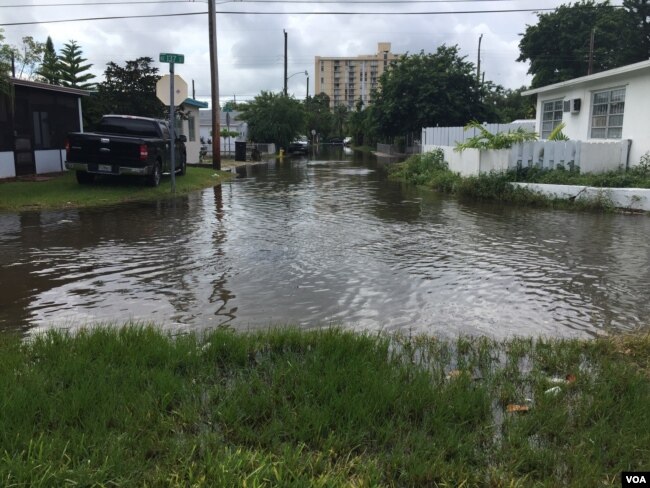But as the oceans rise with climate change, the opposite is happening more and more often. When tides are at their highest, salt water flows up through the drains in low-lying neighborhoods across the Miami area. At its worst, flooding turns streets into impassable streams. It’s a symptom of climate change that’s expected to get worse in the coming decades. Bhat recently moved to the region with his wife, who was born and raised here. “I’m starting to put down roots here as well,” he said. “Miami’s a beautiful place. We don’t want it to be impacted by sea level rise in the way that the projections are putting out there.”
Reality check
While tidal flooding currently happens just a few days each year, “by 2030, we could be seeing it 30 to 40 days a year,” Keren Bolter, climate and policy analyst with the South Florida Regional Planning Council, said. “And by 2060, we could be seeing it almost every single day at high tide. “It’s a wake-up call,” Bolter added. “It’s a reality check of what the future will be every day.” That’s why Bhat and 74 other volunteers are splashing through puddles across the city this morning, collecting data to help scientists understand how rising seas will affect their hometown.
Tidal flooding in Highland Village, North Miami Beach. As tidal flood waters rise, among the things that city officials and scientists need to know is whether the water poses a health risk.
When the waters rise, cities need to know street by street who and what is at risk. And they need to know what combinations of conditions turn streets into streams, and which just leave salty puddles. Plus, they need to know if floods pose a health risk. The rising waters could carry nasty bacteria from septic systems or pet waste, or toxic chemicals that wash off streets and driveways. Collecting all that data requires a lot of manpower. That’s where Tiffany Troxler’s platoon of volunteers comes in. “You simply can’t cover the number of sites that we’re working on today with the research infrastructure that we have at our disposal,” said Troxler, director of the Sea Level Solutions Center at Florida International University.
Citizen scientists
Before sunrise, the citizen scientists gather for doughnuts and training. They learn a few simple techniques, then spread out across the city. As the tide rises, peaks and falls, volunteers collect data on how deep the floodwaters get. They check the salinity to be sure the water is from the bay, not just backed-up rainwater. And they sample for chemicals and bacteria. But there’s more to the exercise than manpower. Troxler says these outings are a great way to get people thinking and talking about what sea level rise will mean for them and their communities. “Even for myself, I don’t think I really appreciated how urgent the issue of sea level rise was until I saw the water coming out of the drain,” she said. “And it just doesn’t stop.”
MORE




